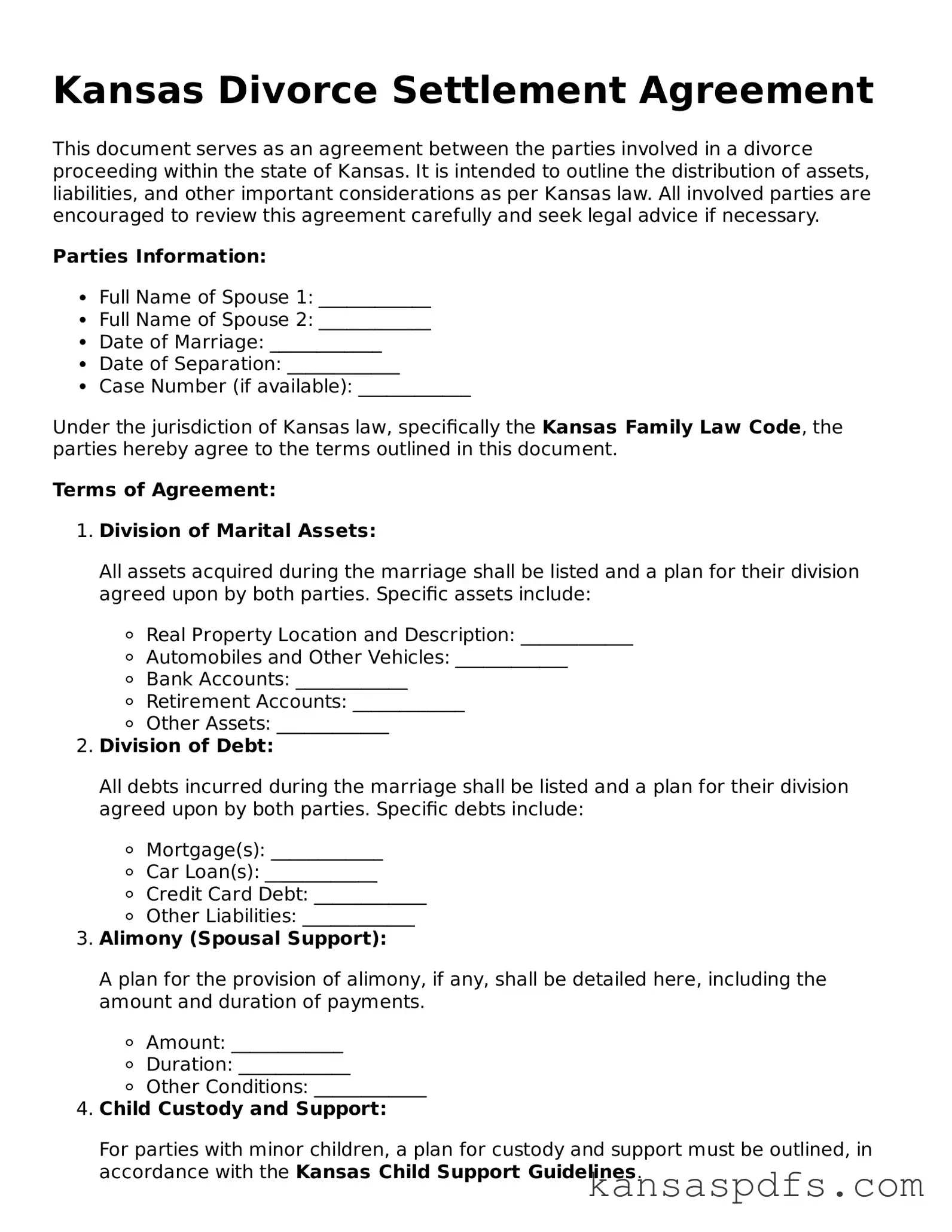What is a Kansas Divorce Settlement Agreement Form?
A Kansas Divorce Settlement Agreement Form is a legally binding document that outlines how the parties involved in a divorce agree to divide their assets, liabilities, and responsibilities. It may also cover matters relating to alimony, child support, and custody arrangements. This agreement is tailor-made to fit the unique needs of the divorcing couple and must be approved by a Kansas court to be enforceable.
Who should use a Kansas Divorce Settlement Agreement Form?
This form is intended for use by individuals who are undergoing a divorce process in the state of Kansas and have reached an agreement on the division of their assets, liabilities, and parental responsibilities, if applicable. It's especially beneficial for those seeking to avoid the uncertainty of a court decision and prefer to make these decisions mutually.
When should the Divorce Settlement Agreement Form be completed?
The Divorce Settlement Agreement Form should ideally be completed after both parties have negotiated and agreed upon the terms but before they submit their final divorce paperwork to a Kansas court. Finalizing the agreement beforehand ensures that all decisions regarding property division, child support, and other critical issues are mutually satisfactory.
Can the agreement be modified after it is signed?
Yes, modifications can be made to the agreement after it is signed if both parties consent to the changes. These modifications must also be submitted to and approved by the court to become effective. Significant changes in circumstances, such as in income, health, or living arrangements, may warrant a review and revision of the agreement.
What is required for the agreement to be legally binding?
To be legally binding in Kansas, the Divorce Settlement Agreement must be signed by both parties, notarized, and approved by a judge. The agreement must also be equitable and fair to both parties, and full disclosure of assets and liabilities by both sides is required for court approval.
Does the agreement cover child support and custody?
Yes, the Kansas Divorce Settlement Agreement can include detailed arrangements regarding child support, custody, and visitation rights. These sections should clearly outline the responsibilities of each parent, amount of support, and custody schedules to ensure the well-being of the children involved.
How does the agreement affect alimony?
Alimony, also known as spousal support, can be included in the Divorce Settlement Agreement. The document should specify the amount, duration, and conditions under which one party will provide financial support to the other. Any agreement on alimony must also gain court approval to be enforceable.
What happens if we cannot agree on certain terms?
If both parties cannot agree on certain terms, they might find it helpful to seek mediation to reach an agreement. If an agreement still cannot be made, the unresolved issues will likely need to be decided by a judge in court, which could result in a less favorable outcome for one or both parties.
Is a lawyer necessary to complete the Divorce Settlement Agreement?
While it is not legally required to have a lawyer to complete the Divorce Settlement Agreement, seeking legal advice is highly recommended. A lawyer can provide guidance, ensure that the agreement complies with Kansas law, and help protect your rights throughout the process.
How long does it take for the agreement to be approved by the court?
The time it takes for a Kansas court to review and approve a Divorce Settlement Agreement can vary. It depends on the court's workload, the completeness of the agreement, and whether the court requires any additional information. Once submitted, it typically takes a few weeks to several months for approval.
